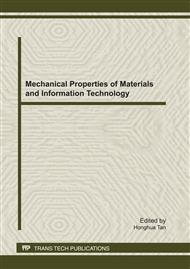[1]
Cai, Q.M., Gao, X.Y., Chen, Y.W. and Ma, S.W. 1995 Dynamic variations of water quality in Taihu Lake and multivarite analysis of its influential factor. Journal pf Lake Sciemces 7: 98-106.
Google Scholar
[2]
Du, Y., Chen, P. and Kieko, S. 2005 Hajime AOE, He Bao-yin, Current water environment status and dominant factor analysis in Honghu lake. Resources and Environment in the Yangtze Basin 14, 482-485.
Google Scholar
[3]
Gong, L.J., Xiong, B.X., Zhou, M., Huang, J. and Zhou, H.J. 2005 Application of principal component analysis in Fishery. Freshwater Fishery Supplement, 52-54.
Google Scholar
[4]
Huang, B., Zhao, Y.F., Shi, X.Z., Yu, D.S., Zhao, Y.C., Sun, W.X., Wang, H.J. and Oborn, I. 2007 Source identification and spatial variability of nitrogen, phosphorus, and selected heavy metals in surface water and sediment in the riverine systems of a peri-urban interface. Journal of Environment Science and Health Part A Toxic/Hazardous Substances and Eenvironmental Engineering 42, 371-380.
DOI: 10.1080/10934520601144675
Google Scholar
[5]
Li, F.C., Liu, C.Q., Guan, Y.Q., Liu, W.W. and Kang, X.J. 2006 Evaluatingcurrent water quality of Baiyangdian Lake by using multi-variate analysis. Journal of Hebei University (natural Science Edition) 26, 405-410.
Google Scholar
[6]
Li, R.Q., Dong, M., Zhao, Y., Zhang, L.L., Cui, Q.G. and He, W.M. 2007 Assessment of water quality and identification of pollution sources of plateau lakes in Yunnan (China). Journal of Environmental Quality 36, 291-297.
DOI: 10.2134/jeq2006.0165
Google Scholar
[7]
Liao, Q.Z. and Lu, X.C. 1988 The factor analysis of environmental chemical characteristicsin sandan lake. J. Huazhong Univ. of Sci. & Tech 26, 65-67.
Google Scholar
[8]
Lu, J., Wu, H.J., Lin J.D., Cui, B. and Lu, Y.Y. 2005 Application of Principal Component and cluster analysis in the urban aquatic ecologcaiil region classification. J. Wuhan Univ. (Nat. Sci. Ed. ) 51, 461-466.
Google Scholar
[9]
Mónica, D., Fernando, P., Colin, R. and Pedro, T. 2007 Chemical composition and the nitrogen-regulated trophic state of Patagonian lakes. Limnologica - Ecology and Management of Inland Waters 37, 17-27.
DOI: 10.1016/j.limno.2006.08.006
Google Scholar
[10]
Ning, L.M., Wang, X.L. and Zhu, M.Y. 2007Application of cluster analysis in the classfication of Jianghan Lake Group. Resources and Environment in the Yangtze Basin 16, 118-122.
Google Scholar
[11]
Pedrozo, C.S. and Rocha, O. 2007 Environmental quality evaluation of lakes in the Rio Grande do Sul coastal plain. Brazilian Archives of Biology and Technology 50, 673-685.
DOI: 10.1590/s1516-89132007000400013
Google Scholar
[12]
Petaloti, C., Voutsa, D., Samara, C., Sofoniou, M., Stratis, L. and Kouimtzis, T. 2004 Nutrient dynamics in shallow lakes of northern Greece. Environmental Science and Pollution Research 11, 11-17.
DOI: 10.1065/espr2003.06.156
Google Scholar
[13]
Tokalioglu, S. and Kartal, S. 2002 Chemometrical interpretation of lake waters after their chemical analysis by using aas, flame photometry and titrimetric techniques. International Journal of Environmental analytical chemistry 82, 291-305.
DOI: 10.1080/03067310290018802
Google Scholar
[14]
Wang, X., Lu, Y., Han, J., He, G. and Wang, T. 2007 Identification of anthropogenic influences on water quality of rivers in Taihu watershed. Journal of Environmental Sciences 19, 475-481.
DOI: 10.1016/s1001-0742(07)60080-1
Google Scholar
[15]
Yu, C.H. 2007 SPSS and Statistical Analysis. Beijing, Electronics Industry Press, Feb, China 26, 65-67.
Google Scholar
[16]
Zuo, Y.M., Cui, G.P. and Feng, J. 2005 Study on correlativity of water qualiti indexes of Taihu lake. People's Yangtze 36, 29-30.
Google Scholar


